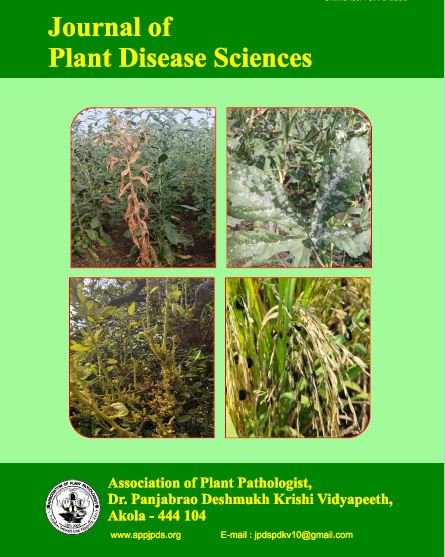STUDIES ON EPIDEMIOLOGY OF CAUSING POWDERY MILDEW OF FENUGREEK
DOI:
https://doi.org/10.48165/jpds.2024.19.02.05Keywords:
Fenugreek, Powdery Mildew, Epidemiology, Erysiphe polygoniAbstract
Fenugreek (Trigonella foenum-graecum L.), locally known as “Methi,” belongs to the family Fabaceae. It is an ancient and well-known spice and vegetable crop in India. India is the largest producer of fenugreek in the world, with major cultivation in states like Rajasthan, Gujarat, Haryana, Madhya Pradesh, and Uttar Pradesh.Powdery mildew of fenugreek, caused by Erysiphe polygoni DC, is a significant and serious disease, especially during the flowering and pod formation stages, leading to substantial losses in both grain quantity and quality. Epidemiological studies indicate that the disease typically appears around 52 days after sowing (DAS) during the rabi season. In Navsari district, the disease occurs at moderate to high levels throughout the year. The infection produces a large quantity of inoculum, and in the presence of heavy pathogen load, it spreads across all leaf surfaces, including upper, middle, and lower portions. Weather conditions between the 3rd and 6th standard meteorological week (SMW) during the rabi season play a crucial role in the development of powdery mildew. The maximum and minimum temperatures favorable for disease severity range from 27.6°C to 35.1°C under field conditions. Notably, minimum temperature showed a significant positive correlation with the intensity of powdery mildew infection.References
Bakar, A. K. (1981). Pest and disease problems of mungbean in West Malaysia. Malaysian Agricultural Journal, 53, 29-33.
Dhingra, K. L., & Chenulu, V. V. (1985). Effect of yellow mosaic on yield and nodulation of soybean. Indian Phytopathology, 38(2), 248-251.
Govindan, K., Nagarajan, P., & Angappan, K. (2014). Molecular studies on the transmission of MYMV by Bemisia tabaci in mungbean. African Journal of Agricultural Research, 9, 2874-2879.
Lodhi, M. A., Ye, G. N., Weeden, N. F., & Reisch, B. (1994). A simple and efficient method for DNA extraction from grapevine cultivars and Vitis species. Plant Molecular Biology Reporter, 12, 16-13.
Malathi, V. G., & John, P. (2008). Geminiviruses infecting legumes. In G. P. Rao, P. Lava Kumar, & R. J. Holguin-Pena (Eds.), Characterization, Diagnosis & Management of Plant Viruses, Volume 3: Vegetables and Pulse Crops (pp. 97-123). Stadium Press LLC, Texas, USA.
Maruthi, M. N., Colvain, J., Seal, S. E., Gibson, G., & Cooper, J. (2002). Co-adaptation between cassava mosaic geminivirus and their local vector population. Virus Research, 86, 71-85.
Nene, Y. L. (1973). Control of Bemisia tabaci Genn., a vector of several plant viruses. Indian Journal of Agricultural Sciences, 43, 433–436.
Sethuraman, K., Manivannan, & Natarajan (2001). Management of yellow mosaic disease of urdbean using neem products. Legume Research, 24, 197-199.
Singh, D. P. (1980). Inheritance of resistance to yellow mosaic virus in black gram (Vigna mungo (L.) Hepper). Theoretical and Applied Genetics, 57, 233-235.
Williams, F. J., Grewal, J. S., & Amin, K. S. (1968). Serious and new diseases of pulse crops in India in 1966. Plant Disease Reporter, 52, 300-304.

